2001 Honda 500cc Big Bore
| Ride Review: Honda Unveils 500cc Big-Bore New High-Tech Hondamatic Offers Three-Dimensional Transmission |
 |
1. The model defined the class. -Or-
2. The model re-defined the class.
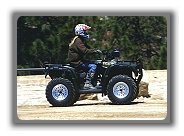 may have achieved both this time.
may have achieved both this time. The Rubicon project actually started 5 years ago when Honda decided to enter the immensely popular automatic transmission ATV market. Honda engineers were so meticulous and thorough with the design process that some projects started after the Rubicon were introduced to the market before it (The entire Rancher line). Across the USA over ½ million ATVs were sold last year of which 83% were utility machines. Honda noticed the publics interest in ATV’s with automatic transmission’s and decided to “jump on the boat” but in a completely different manner. Starting with a clean sheet of paper, a dream and an innovative team of engineers, Honda has created the most technologically advanced ATV to date.
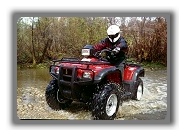 The Rubicon looks like the Foreman 450’s, but that’s where the similarities end folks. The Rubicon is an entirely new machine from the ground up and shares few parts with other models. Indeed, with the superb Foreman 450, Honda had a very good model to improve upon and compare to. Overall it is slightly larger than the 450’s in nearly all dimensions. The chassis feel, suspension action and riding experience is very similar to the 450 Foreman’s–only better. The seating arrangements are comfortable enough for all day exploring and the saddle gets the angled side treatment similar to the comfy Rancher.
The Rubicon looks like the Foreman 450’s, but that’s where the similarities end folks. The Rubicon is an entirely new machine from the ground up and shares few parts with other models. Indeed, with the superb Foreman 450, Honda had a very good model to improve upon and compare to. Overall it is slightly larger than the 450’s in nearly all dimensions. The chassis feel, suspension action and riding experience is very similar to the 450 Foreman’s–only better. The seating arrangements are comfortable enough for all day exploring and the saddle gets the angled side treatment similar to the comfy Rancher.| Rubicon |
 450 S / ES |
|
| Overall Length | 81.6″ | 77.2″ |
| Overall Width | 46.6″ | 45.5″ |
| Seat Height | 33.9″ | 33.8″ |
| Ground Clearance | 10.0″ | 7.7″ |
| Wheelbase | 50.9″ | 50.0″ |
| Dry Weight | 600-pounds | 573-pounds |
| Suspension Travel (F/R) | 6.9″ / 6.9″ | 5.9″ / 5.9″ |
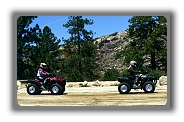 The beautiful mountains of the San Bernardino National Forest in California offered a varied terrain and proved to be an excellent testing ground. We took the Rubicon through everything from rocks and sand to fallen timber, snow and mud. After all was said and done, we came away impressed. Riding the Rubicon revealed improvements in suspension action, stability and handling compared to the
The beautiful mountains of the San Bernardino National Forest in California offered a varied terrain and proved to be an excellent testing ground. We took the Rubicon through everything from rocks and sand to fallen timber, snow and mud. After all was said and done, we came away impressed. Riding the Rubicon revealed improvements in suspension action, stability and handling compared to the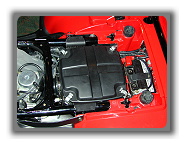 450 Foreman’s. Most of the thanks go to the premium Showa Shocks sporting an ultra plush 6.7 inches of travel front and rear. The wheelbase (front to rear tire distance) and track (left to right tire footprint width) have been increased which also aids in stability, handling and ride comfort. A relentless quest to keep the center of gravity low and mass centralized paid off big time with neutral handling and great off-camber manners. An equally impressive feat was engineering 10 inches of ground clearance while keeping overall height and center of gravity down low. The low speed suspension action was very good and all but the nastiest trail projections were gobbled up without the rider even noticing their existence. High-speed action was also quite good offering confidence and control on rough trails at speed. We were not able to run it through our usual obstacle courses and test loops and we were not able to do any log jumps or similar suspension tests but it feels up to the task.
450 Foreman’s. Most of the thanks go to the premium Showa Shocks sporting an ultra plush 6.7 inches of travel front and rear. The wheelbase (front to rear tire distance) and track (left to right tire footprint width) have been increased which also aids in stability, handling and ride comfort. A relentless quest to keep the center of gravity low and mass centralized paid off big time with neutral handling and great off-camber manners. An equally impressive feat was engineering 10 inches of ground clearance while keeping overall height and center of gravity down low. The low speed suspension action was very good and all but the nastiest trail projections were gobbled up without the rider even noticing their existence. High-speed action was also quite good offering confidence and control on rough trails at speed. We were not able to run it through our usual obstacle courses and test loops and we were not able to do any log jumps or similar suspension tests but it feels up to the task. 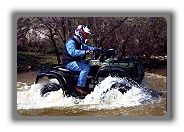 The steering effort is light and low speed maneuvers are a breeze partly due to the torque sensing front differential. The Rubicon is equipped with Honda’s clutchless torque sensing differential, which in theory senses wheel spin and applies engine power to the wheel with the most traction. “In theory” is one thing; “real world use” is usually an entirely different animal–not this time though. The Differential works superbly making the Rubicon one of the most tractable limited-slip ATVs ever, though the transmissions ability to reduce wheelspin in the auto shift modes helps there too. Sometimes during sharp low speed turns on slippery surfaces the differential would “engage” or “switch” causing the machine to understeer requiring a K turn or steering correction to complete the maneuver. While not as effective as true 4WD, it bridges the gap between 4WD and conventional clutch diffs quite nicely.
The steering effort is light and low speed maneuvers are a breeze partly due to the torque sensing front differential. The Rubicon is equipped with Honda’s clutchless torque sensing differential, which in theory senses wheel spin and applies engine power to the wheel with the most traction. “In theory” is one thing; “real world use” is usually an entirely different animal–not this time though. The Differential works superbly making the Rubicon one of the most tractable limited-slip ATVs ever, though the transmissions ability to reduce wheelspin in the auto shift modes helps there too. Sometimes during sharp low speed turns on slippery surfaces the differential would “engage” or “switch” causing the machine to understeer requiring a K turn or steering correction to complete the maneuver. While not as effective as true 4WD, it bridges the gap between 4WD and conventional clutch diffs quite nicely.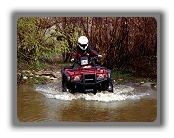 The 499cc liquid cooled, longitudinally mounted, over-head-valve four-stroke motor is an all new design built specifically for the Rubicon. It incorporates many engineering firsts for ATV’s and Honda Motor Company. Some notable features are:
The 499cc liquid cooled, longitudinally mounted, over-head-valve four-stroke motor is an all new design built specifically for the Rubicon. It incorporates many engineering firsts for ATV’s and Honda Motor Company. Some notable features are:  |
 |
 |
 |
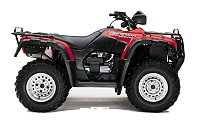 The 499-cc powerplant starts easily via a handlebar mounted start button and engine vibration is minimal. Describing and comparing the engine becomes difficult, as the transmission is somewhat alien in operation and rider sensation when compared to a belt driven automatic, its closest relative. Overall engine power was down slightly due to the 4,000 to 5,500 ft elevation and the fact that all the test machines were “as delivered” from a dealer and not re-jetted for altitude. The low-end power feels soft and lazy, partly due to a very low clutch engagement and the transmission doing its job of maintaining traction while being very smooth. Hopping on a Foreman 450 brought along for comparison felt stronger initially but actually resulted in slower acceleration. Lifting or lightening the front end for obstacles using engine power is a bit difficult and requires an aggressive tug to help. Mid range and top end power is quite good for a sport/utility machine. The Rubicon’s combination of a head mounted cam, shortened pushrods and increased valve area over it’s 450 brother results in a wider powerband with better breathing at higher RPM
The 499-cc powerplant starts easily via a handlebar mounted start button and engine vibration is minimal. Describing and comparing the engine becomes difficult, as the transmission is somewhat alien in operation and rider sensation when compared to a belt driven automatic, its closest relative. Overall engine power was down slightly due to the 4,000 to 5,500 ft elevation and the fact that all the test machines were “as delivered” from a dealer and not re-jetted for altitude. The low-end power feels soft and lazy, partly due to a very low clutch engagement and the transmission doing its job of maintaining traction while being very smooth. Hopping on a Foreman 450 brought along for comparison felt stronger initially but actually resulted in slower acceleration. Lifting or lightening the front end for obstacles using engine power is a bit difficult and requires an aggressive tug to help. Mid range and top end power is quite good for a sport/utility machine. The Rubicon’s combination of a head mounted cam, shortened pushrods and increased valve area over it’s 450 brother results in a wider powerband with better breathing at higher RPM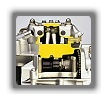
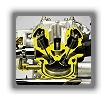 Now the moment everyone has been waiting for� The Transmission! How well does it work? How does it feel? Does it need special fluid? Is there any compression braking? Honda says: “The Hondamatic transmission utilizes variable hydraulic pr
Now the moment everyone has been waiting for� The Transmission! How well does it work? How does it feel? Does it need special fluid? Is there any compression braking? Honda says: “The Hondamatic transmission utilizes variable hydraulic pr essure and mechanical torque amplification to provide
essure and mechanical torque amplification to provide seamless job-handling power and acceleration. Engine power drives a hydraulic pump. The pump, in turn, drives a hydraulic motor with variable fluid capacity. Utilizing pump and motor pistons and a variable-pitch motor-side swash plate, hydraulic capacity and pressure are varied, producing continuously variable output speed. In addition, torque is increased as output shaft speed is reduced.” We say: “It’s a very slick unit that plain and simply works!”
seamless job-handling power and acceleration. Engine power drives a hydraulic pump. The pump, in turn, drives a hydraulic motor with variable fluid capacity. Utilizing pump and motor pistons and a variable-pitch motor-side swash plate, hydraulic capacity and pressure are varied, producing continuously variable output speed. In addition, torque is increased as output shaft speed is reduced.” We say: “It’s a very slick unit that plain and simply works!” Based on the Badalini Stepless transmission that made its Honda debut in the 1962 Juno scooter, it is a highly evolved variant of the original. Perhaps you have heard the term “hydrostatic transmission” when describing a type of lawn and garden tractor transmission? The Hondamatic transmission is basically a hydrostatic transmission with a computer controlled servo-motor controlling output rather than a manually operated lever or pedal. It can also be operated in the ESP mode (Electric Shift Program) with 5 operator actuated settings or “gears”. The hydrostatic pump is powered by engine oil so no special fluids are needed.
Based on the Badalini Stepless transmission that made its Honda debut in the 1962 Juno scooter, it is a highly evolved variant of the original. Perhaps you have heard the term “hydrostatic transmission” when describing a type of lawn and garden tractor transmission? The Hondamatic transmission is basically a hydrostatic transmission with a computer controlled servo-motor controlling output rather than a manually operated lever or pedal. It can also be operated in the ESP mode (Electric Shift Program) with 5 operator actuated settings or “gears”. The hydrostatic pump is powered by engine oil so no special fluids are needed. Riding the Rubicon is easy and the transmission requires very little operator input. First select the mechanical gear range for the expected conditions-High or Low range. We found low range ideal for most tight slower speed trails. Next, select one of the automatic shift programs or the manually operated ESP. We found that D1 worked best for most situations we encountered when in high range.
Mechanical Gear Range Selections
|
Low
|
Towing, hauling, slower trails requiring strong power. (Automatically selects D2.) |
|
|
High
|
Faster trails, higher speeds.
|
| D1 — No Shifting | Horsepower Mode | Most normal riding, used 99% of the time by most people. Keeps engine in the upper RPM at peak HP. | |
| D2 — No Shifting | Torque Mode | For heavy towing or situations requiring maximum traction with no wheelspin. Keeps engine at mid RPM at the torque peak. | |
| ESP — Thumb Switch Shifting | Electric Shift Program | Manual operator control of 5 hydrostatic positions. (5 speed) |
 The Hondamatic is a very well thought out design and makes belt drive transmissions seem a bit outdated in comparison. The power is incredibly smooth with no jerks or delays. You can not feel the transmission “shifting” or changing ratios; all the operator feels is continuous, smooth power. It is also much quieter than a typical belt drive with no belts to wear or break and leave you stranded. Routine transmission maintenance consists of changing the oil and cartridge style filter at regular intervals like any normal 4-stroke engine. Riding the Rubicon in D1 or D2 is a little strange at first because regardless of throttle application the engine RPM stays somewhat constant. D1, D2 or ESP can all be selected “on the fly” but will not actually change until the ATV comes to a complete stop. We realize Honda chose this stop first protocol for safety and liability reasons but do not necessarily agree with it. We feel the ability to switch from D1 to D2 to maximize traction on a slippery uphill climb without coming to a complete stop would be a very desirable feature. How is the engine braking? Super! The hydraulic transmission motor being driven in reverse while coasting achieves engine braking. The same 6 sensors and CPU control it as the forward drive system for maximum effect, possibly better than a gear driven machine. Overall, a very impressive transmission.
The Hondamatic is a very well thought out design and makes belt drive transmissions seem a bit outdated in comparison. The power is incredibly smooth with no jerks or delays. You can not feel the transmission “shifting” or changing ratios; all the operator feels is continuous, smooth power. It is also much quieter than a typical belt drive with no belts to wear or break and leave you stranded. Routine transmission maintenance consists of changing the oil and cartridge style filter at regular intervals like any normal 4-stroke engine. Riding the Rubicon in D1 or D2 is a little strange at first because regardless of throttle application the engine RPM stays somewhat constant. D1, D2 or ESP can all be selected “on the fly” but will not actually change until the ATV comes to a complete stop. We realize Honda chose this stop first protocol for safety and liability reasons but do not necessarily agree with it. We feel the ability to switch from D1 to D2 to maximize traction on a slippery uphill climb without coming to a complete stop would be a very desirable feature. How is the engine braking? Super! The hydraulic transmission motor being driven in reverse while coasting achieves engine braking. The same 6 sensors and CPU control it as the forward drive system for maximum effect, possibly better than a gear driven machine. Overall, a very impressive transmission.Brakes/Controls
 All controls and levers display the typical Honda quality feel and are located right where they should be. Nothing feels out of place and all the controls feel just right. Honda engineers spend insane amounts of time on matters as seemingly simple as the shape of a rotary knob or the arc of its total travel in degrees. The end result being an excellent control and lever package. The only point we feel that could improve the package would be backlit controls and switches for nocturnal missions.
All controls and levers display the typical Honda quality feel and are located right where they should be. Nothing feels out of place and all the controls feel just right. Honda engineers spend insane amounts of time on matters as seemingly simple as the shape of a rotary knob or the arc of its total travel in degrees. The end result being an excellent control and lever package. The only point we feel that could improve the package would be backlit controls and switches for nocturnal missions. Braking is provided via the familiar Honda fashion, hydraulically actuated dual sealed drums in front and a single mechanical drum in the rear. Both offer excellent braking performance with light operator effort, nothing fancy, but a tried and proven setup. The Rubicon displays the same loss of braking performance when traveling backwards down hills (as in a failed hillclimb attempt) as we noted on the 450 ES.
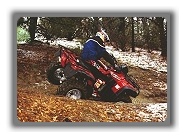 For those that like to bring along accessories, there is a 330-watt alternator and a dash mounted 12 VDC socket rated at a healthy 12 amperes. To carry those accessories or whatever else you wish, there is a set of beefy front and rear metal racks rated at 66 and 133 lbs. High luster aluminum wheels have been added to keep overall weight down while looking fabulous. The digital display pod style speedometer/information center is similar to the unit on the 450 Foreman’s and remains our favorite dash setup. There is a small to medium sized rear mounted storage box that sports a rubber gasket and does a decent job of keeping its contents dry. The Rubicon’s fenders and floorboards also do a good job of keeping the rider clean and dry.
For those that like to bring along accessories, there is a 330-watt alternator and a dash mounted 12 VDC socket rated at a healthy 12 amperes. To carry those accessories or whatever else you wish, there is a set of beefy front and rear metal racks rated at 66 and 133 lbs. High luster aluminum wheels have been added to keep overall weight down while looking fabulous. The digital display pod style speedometer/information center is similar to the unit on the 450 Foreman’s and remains our favorite dash setup. There is a small to medium sized rear mounted storage box that sports a rubber gasket and does a decent job of keeping its contents dry. The Rubicon’s fenders and floorboards also do a good job of keeping the rider clean and dry. Its revolutionary transmission, excellent ergonomics, big cc engine and Honda’s proven ability to build high quality dependable machines add up to a very desirable utility machine . The transmission alone is enough to proclaim it “Best new ATV model” while everything else is just icing on the cake. Our gripes? It would be nice to be able to switch between (and actually engage) the D1 and D2 transmission settings on the fly without stopping first. A switchable 2-wheel drive/4-wheel drive system would also be a well received addition and seems to be where the 4×4 market is heading. How will it compare with the other premium big bores? We won’t know for sure until we actually have the “Battle of the Titans,” however we do know it will be one heck of a fight.
Its revolutionary transmission, excellent ergonomics, big cc engine and Honda’s proven ability to build high quality dependable machines add up to a very desirable utility machine . The transmission alone is enough to proclaim it “Best new ATV model” while everything else is just icing on the cake. Our gripes? It would be nice to be able to switch between (and actually engage) the D1 and D2 transmission settings on the fly without stopping first. A switchable 2-wheel drive/4-wheel drive system would also be a well received addition and seems to be where the 4×4 market is heading. How will it compare with the other premium big bores? We won’t know for sure until we actually have the “Battle of the Titans,” however we do know it will be one heck of a fight.Engine Type: 499cc liquid-cooled OHV dry-sump longitudinally mounted single-cylinder four-stroke
Bore and Stroke: 92.0mm x 75.0mm
Carburetion: 33.5mm CV
Ignition: DC CDI
Starter: Electric with auxiliary recoil
Transmission: Fully automatic hydromechanical, continuously variable with electronic controls
Driveline: Direct front and rear drive-shafts with torque-sensing limited-slip front differential
Suspension: Front: Independent double-wishbone; 6.7 inches travel
Rear: Swingarm with dual shock absorbers; 6.7 inches travel
Brakes: Front: Triple-sealed hydraulic drum Rear: Sealed mechanical drum
Tires: Front: 25 x 8 – 12 Rear: 25 x 10 – 12 Length: 81.6 inches
Width: 46.6 inches
Height: 47.0 inches
Seat Height: 33.9 inches
Ground Clearance: 10.0 inches
Wheelbase: 50.9 inches
Turning Radius: 10.8 feet
Dry Weight: 600 pounds
Fuel Capacity: 3.7 gallons, including 1.0-gallon reserve
Colors: Red, Olive

